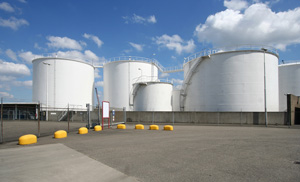|
Above & Underground Storage Tank Management
|
 Bulk storage is typically regulated and separated into two
types; aboveground storage tanks (ASTs) and underground storage
tanks (USTs). These storage vessels typically require
permits or registrations for construction or operation.
Usually, the driving factors with respect to requirements are the
size of the vessel and the material stored. In addition to
specific AST or UST authorizations, the facility may also require
these vessels to be addressed in air and water authorizations for
the facility. Regulatory requirements associated with ASTs
and USTs vary greatly by State. In certain instances a State
environmental agency is responsible for such authorizations, while
in others it is a Fire Marshall, County Building Department or no
specific requirements may exist. Bulk storage is typically regulated and separated into two
types; aboveground storage tanks (ASTs) and underground storage
tanks (USTs). These storage vessels typically require
permits or registrations for construction or operation.
Usually, the driving factors with respect to requirements are the
size of the vessel and the material stored. In addition to
specific AST or UST authorizations, the facility may also require
these vessels to be addressed in air and water authorizations for
the facility. Regulatory requirements associated with ASTs
and USTs vary greatly by State. In certain instances a State
environmental agency is responsible for such authorizations, while
in others it is a Fire Marshall, County Building Department or no
specific requirements may exist.
It is imperative that a site’s specific requirements be
determined early on to ensure appropriate design and installation
of storage equipment (vessels) as cost overruns and project delays
can severely hinder a project. Knowing what requirements
exist for your application is important so that proper materials
(i.e.: double-walled tanks and piping, secondary containment or
interstitial monitoring) can be incorporated at the right time.
Once you have installed bulk storage vessels, it is important that
you understand the operational requirements associated with the
equipment. RTP is well versed in AST and UST requirements
and can help you understand the applicable environmental
requirements. RTP’s diverse knowledge will also
facilitate compliance under a number of other programs that may be
triggered as a result of bulk storage changes including, but not
limited to, air and water permitting, Risk Management Plans (RMP),
Stormwater Pollution Prevention Plans, Spill Prevention Control
and Countermeasure (SPCC) Plans, and Process Safety Management
(PSM). It is critical to a successful environmental
compliance program that these requirements be considered and
satisfied as part of a bulk storage project. RTP can assist
you with developing the appropriate list of environmental
requirements and assuring compliance with applicable rules and
regulations.
|